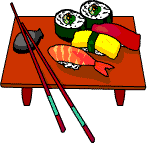Sushi
Created | Updated Jul 16, 2020

Of Japanese origin, sushi is now a popular food in many parts of the world. Eaten with chopsticks or fingers, the noted reactions to sushi range from orgasmic exclamations to gagging while running to the toilet. There is no way to tell which reaction you will have until you try it for yourself.
Sushi consists of three basic parts: rice, seaweed, and topping.
Sushi rice is made with special Japanese short-grained rice. A mixture of sugar, salt, and rice-wine vinegar is folded into the freshly cooked rice while it is cooled with a fan. The addition of the seasoning makes the rice sticky and gives it a slightly sweet flavor.
'Nori' - seaweed that has been roasted into green paper-like sheets - is used in some types of sushi. Typically a 'maki' (or roll) is made by placing rice and topping on a sheet of nori, rolling it up tight with a special bamboo roller, and then cutting it into six to eight bite-sized pieces. Sushi can also come in a 'handroll' which is a cone of nori which has been formed around rice and topping. It can also come in individual pieces called 'nigiri' which may or may not have a small band of nori around the centre (more often it does not), although some nigiri like flying-fish roe comes in a small hand-formed tube of 'nori' which has been wrapped around a small ball of rice on top of which the roe is placed.
The possible toppings for sushi are as endless as your imagination, though the most common is raw fish. Some of the fish used in sushi preparation are tuna, salmon, yellowtail, whitefish, mackerel, and blowfish. Some other seafood related toppings are roe, shrimp, crab, eel, octopus, clam, and sea urchin. Other general toppings include a wide variety of vegetables, pickles, bean curd, and egg.
Sushi is typically served with pink pickled ginger and hot green wasabi in little lumps on the side. The ginger is meant to be a palate cleanser between different types of sushi, but some people like to eat it with the sushi. Sushi is normally dipped into soy sauce. Other condiments sometimes served with sushi are lemon wedges, mint leaves, lettuce, and daikon radish. How much of any condiment used, if any, is entirely up to the discretion of the eater. There are no hard and fast rules.
Aside from the food itself, another aspect of sushi enjoyment is the way it is presented. Usually served on a flat bamboo or ceramic platter, part of the sushi chef's job is to make an aesthetically pleasing arrangement of the sushi and condiments. Before digging in, take a moment to admire the placement of everything on the tray.
Sushi is well accompanied by sake (rice wine), which should be served hot (which makes the alcohol go to the head faster), making a nice complement to the fish itself which is usually served chilled, as well as a bowl of miso soup.
Recently a craze for conveyor-belt sushi restaurants has grown up - such as Moshi Moshi in Liverpool Street Station, London, and various branches of Yo! Sushi (complete with robotic waiters carrying around drinks) - where delicious-looking morsels are prepared in front of you by chefs and paraded past your eyes on circular conveyor-belts! It's a good way to experience sushi for the first time (with no commitment to eat more than one plateful), though not the cheapest.
Bon Appetit!

